Page 366 of 473
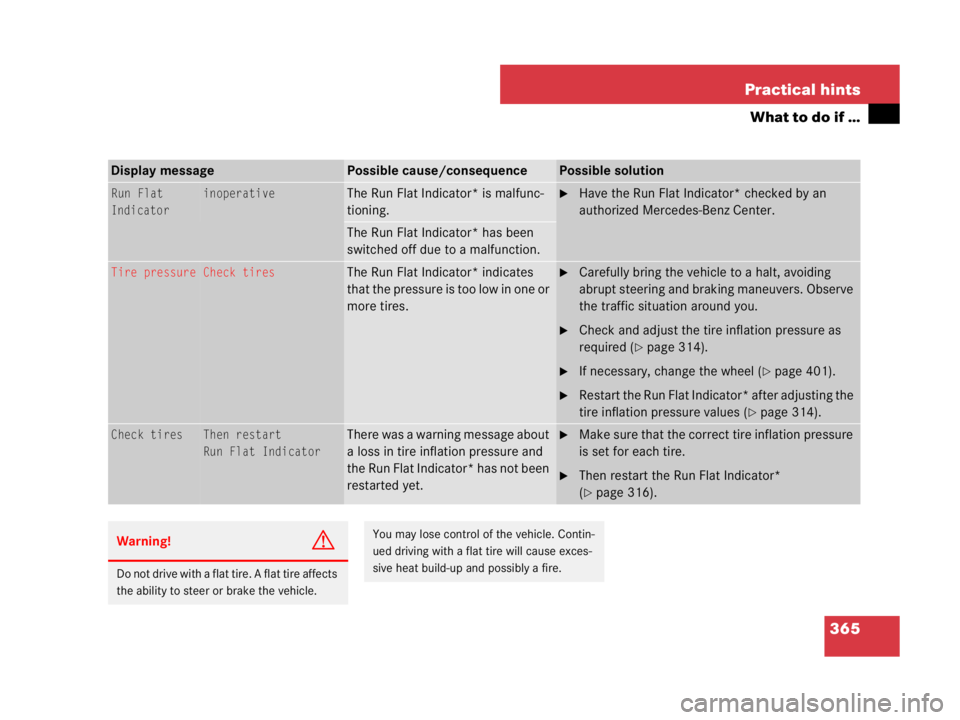
365 Practical hints
What to do if …
Display messagePossible cause/consequencePossible solution
Run Flat
IndicatorinoperativeThe Run Flat Indicator* is malfunc-
tioning.�Have the Run Flat Indicator* checked by an
authorized Mercedes-Benz Center.
The Run Flat Indicator* has been
switched off due to a malfunction.
Tire pressureCheck tiresThe Run Flat Indicator* indicates
that the pressure is too low in one or
more tires.�Carefully bring the vehicle to a halt, avoiding
abrupt steering and braking maneuvers. Observe
the traffic situation around you.
�Check and adjust the tire inflation pressure as
required (
�page 314).
�If necessary, change the wheel (�page 401).
�Restart the Run Flat Indicator* after adjusting the
tire inflation pressure values (
�page 314).
Check tiresThen restart
Run Flat IndicatorThere was a warning message about
a loss in tire inflation pressure and
the Run Flat Indicator* has not been
restarted yet.�Make sure that the correct tire inflation pressure
is set for each tire.
�Then restart the Run Flat Indicator*
(
�page 316).
Warning!G
Do not drive with a flat tire. A flat tire affects
the ability to steer or brake the vehicle.
You may lose control of the vehicle. Contin-
ued driving with a flat tire will cause exces-
sive heat build-up and possibly a fire.
Page 387 of 473
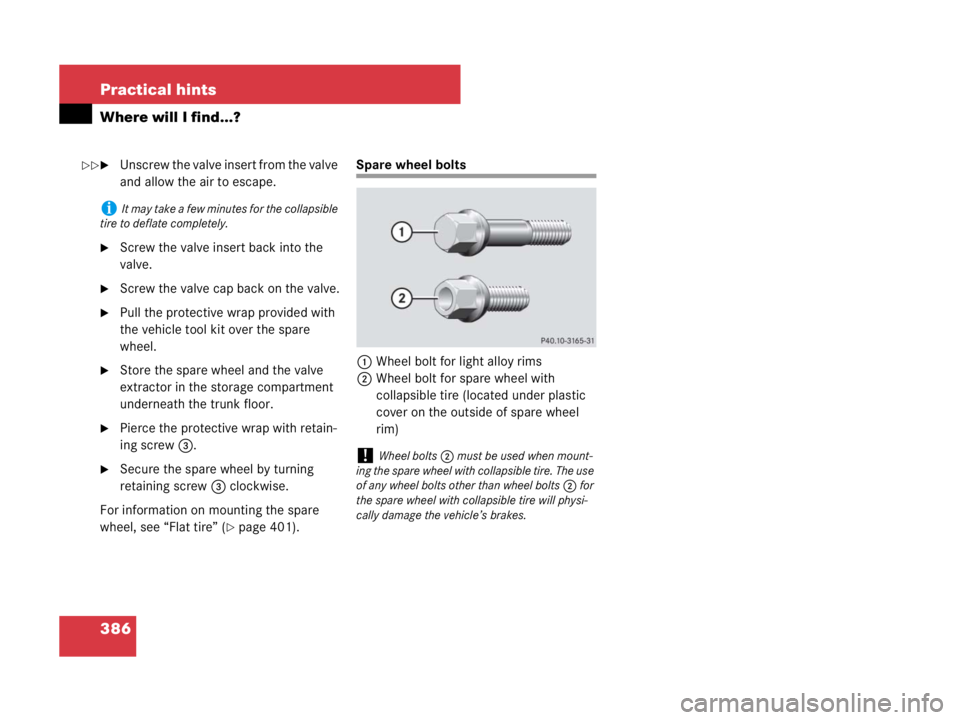
386 Practical hints
Where will I find...?
�Unscrew the valve insert from the valve
and allow the air to escape.
�Screw the valve insert back into the
valve.
�Screw the valve cap back on the valve.
�Pull the protective wrap provided with
the vehicle tool kit over the spare
wheel.
�Store the spare wheel and the valve
extractor in the storage compartment
underneath the trunk floor.
�Pierce the protective wrap with retain-
ing screw3.
�Secure the spare wheel by turning
retaining screw3 clockwise.
For information on mounting the spare
wheel, see “Flat tire” (
�page 401).
Spare wheel bolts
1Wheel bolt for light alloy rims
2Wheel bolt for spare wheel with
collapsible tire (located under plastic
cover on the outside of spare wheel
rim)
iIt may take a few minutes for the collapsible
tire to deflate completely.
!Wheel bolts2 must be used when mount-
ing the spare wheel with collapsible tire. The use
of any wheel bolts other than wheel bolts2 for
the spare wheel with collapsible tire will physi-
cally damage the vehicle’s brakes.
��
Page 402 of 473
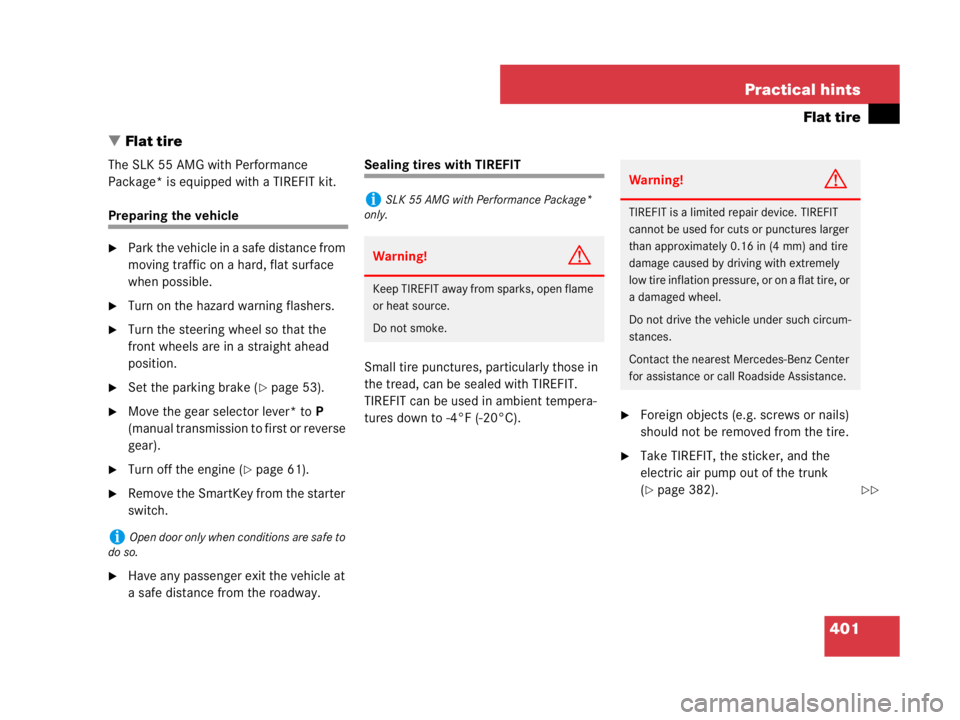
401 Practical hints
Flat tire
�Flat tire
The SLK 55 AMG with Performance
Package* is equipped with a TIREFIT kit.
Preparing the vehicle
�Park the vehicle in a safe distance from
moving traffic on a hard, flat surface
when possible.
�Turn on the hazard warning flashers.
�Turn the steering wheel so that the
front wheels are in a straight ahead
position.
�Set the parking brake (�page 53).
�Move the gear selector lever* toP
(manual transmission to first or reverse
gear).
�Turn off the engine (�page 61).
�Remove the SmartKey from the starter
switch.
�Have any passenger exit the vehicle at
a safe distance from the roadway.
Sealing tires with TIREFIT
Small tire punctures, particularly those in
the tread, can be sealed with TIREFIT.
TIREFIT can be used in ambient tempera-
tures down to -4°F (-20°C).
�Foreign objects (e.g. screws or nails)
should not be removed from the tire.
�Take TIREFIT, the sticker, and the
electric air pump out of the trunk
(
�page 382).
iOpen door only when conditions are safe to
do so.
iSLK 55 AMG with Performance Package*
only.
Warning!G
Keep TIREFIT away from sparks, open flame
or heat source.
Do not smoke.
Warning!G
TIREFIT is a limited repair device. TIREFIT
cannot be used for cuts or punctures larger
than approximately 0.16 in (4 mm) and tire
damage caused by driving with extremely
low tire inflation pressure, or on a flat tire, or
a damaged wheel.
Do not drive the vehicle under such circum-
stances.
Contact the nearest Mercedes-Benz Center
for assistance or call Roadside Assistance.
��
Page 403 of 473
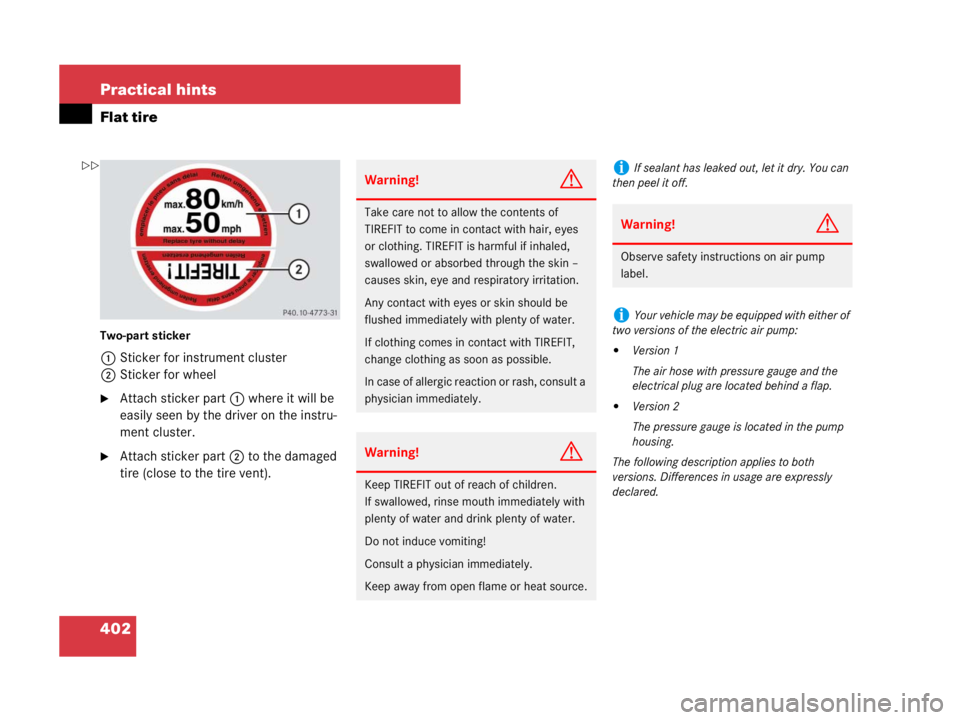
402 Practical hints
Flat tire
Two-part sticker
1Sticker for instrument cluster
2Sticker for wheel
�Attach sticker part 1 where it will be
easily seen by the driver on the instru-
ment cluster.
�Attach sticker part 2 to the damaged
tire (close to the tire vent).
Warning!G
Take care not to allow the contents of
TIREFIT to come in contact with hair, eyes
or clothing. TIREFIT is harmful if inhaled,
swallowed or absorbed through the skin –
causes skin, eye and respiratory irritation.
Any contact with eyes or skin should be
flushed immediately with plenty of water.
If clothing comes in contact with TIREFIT,
change clothing as soon as possible.
In case of allergic reaction or rash, consult a
physician immediately.
Warning!G
Keep TIREFIT out of reach of children.
If swallowed, rinse mouth immediately with
plenty of water and drink plenty of water.
Do not induce vomiting!
Consult a physician immediately.
Keep away from open flame or heat source.
iIf sealant has leaked out, let it dry. You can
then peel it off.
Warning!G
Observe safety instructions on air pump
label.
iYour vehicle may be equipped with either of
two versions of the electric air pump:
�Version 1
The air hose with pressure gauge and the
electrical plug are located behind a flap.
�Version 2
The pressure gauge is located in the pump
housing.
The following description applies to both
versions. Differences in usage are expressly
declared.
��
Page 404 of 473
403 Practical hints
Flat tire
Version 1
1TIREFIT container
2Notch
3Electric air pump switch
4Electrical plug
5Air hose
6Flange
7Flap
Version 2
1TIREFIT container
2Notch
3Electric air pump switch
4Electrical plug
5Air hose
6Flange
�Open flap7 on the electric air pump
(version 1 only).
�Pull plug4 and air hose5 out of the
pump housing.
�Screw the air pump’s air hose5 onto
flange6 of TIREFIT container1.
�Stick TIREFIT container1 upside
down into notch2 of the electric air
pump.
8Filler hose
9Tire valve
�Unscrew the valve cap of the damaged
tire from tire valve9.
��
Page 405 of 473
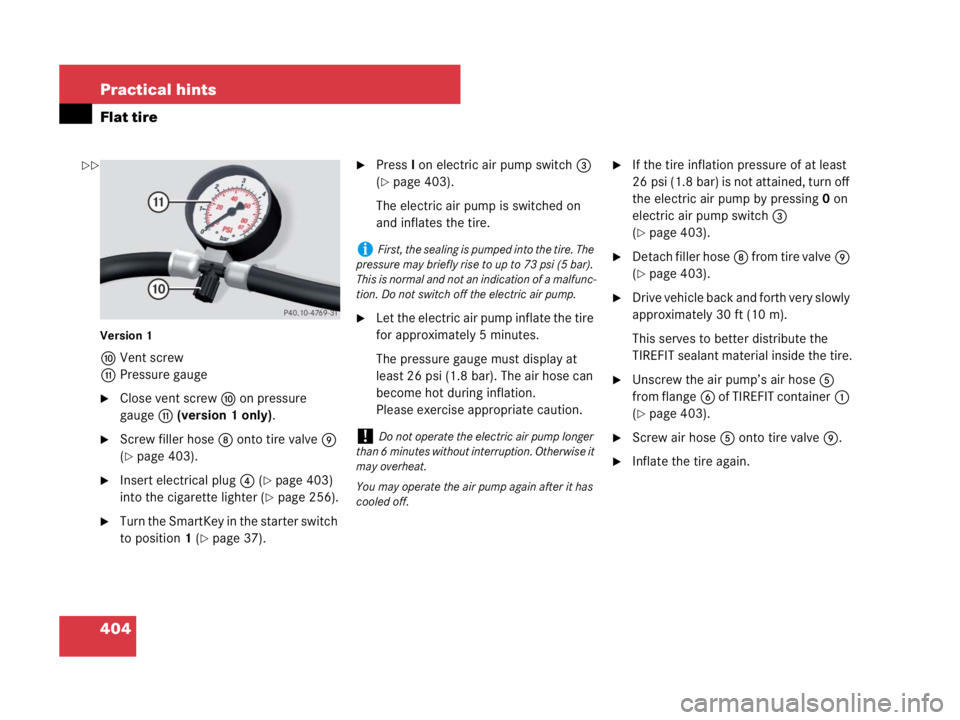
404 Practical hints
Flat tire
Version 1
aVent screw
bPressure gauge
�Close vent screwa on pressure
gaugeb (version 1 only).
�Screw filler hose8 onto tire valve9
(
�page 403).
�Insert electrical plug4 (�page 403)
into the cigarette lighter (
�page 256).
�Turn the SmartKey in the starter switch
to position1 (
�page 37).
�PressI on electric air pump switch3
(
�page 403).
The electric air pump is switched on
and inflates the tire.
�Let the electric air pump inflate the tire
for approximately 5 minutes.
The pressure gauge must display at
least 26 psi (1.8 bar). The air hose can
become hot during inflation.
Please exercise appropriate caution.
�If the tire inflation pressure of at least
26 psi (1.8 bar) is not attained, turn off
the electric air pump by pressing0 on
electric air pump switch3
(
�page 403).
�Detach filler hose8 f r o m t i r e v a l v e9
(
�page 403).
�Drive vehicle back and forth very slowly
approximately 30 ft (10 m).
This serves to better distribute the
TIREFIT sealant material inside the tire.
�Unscrew the air pump’s air hose5
from flange6 of TIREFIT container1
(
�page 403).
�Screw air hose5onto tire valve9.
�Inflate the tire again.
iFirst, the sealing is pumped into the tire. The
pressure may briefly rise to up to 73 psi (5 bar).
This is normal and not an indication of a malfunc-
tion. Do not switch off the electric air pump.
!Do not operate the electric air pump longer
than 6 minutes without interruption. Otherwise it
may overheat.
You may operate the air pump again after it has
cooled off.
��
Page 406 of 473
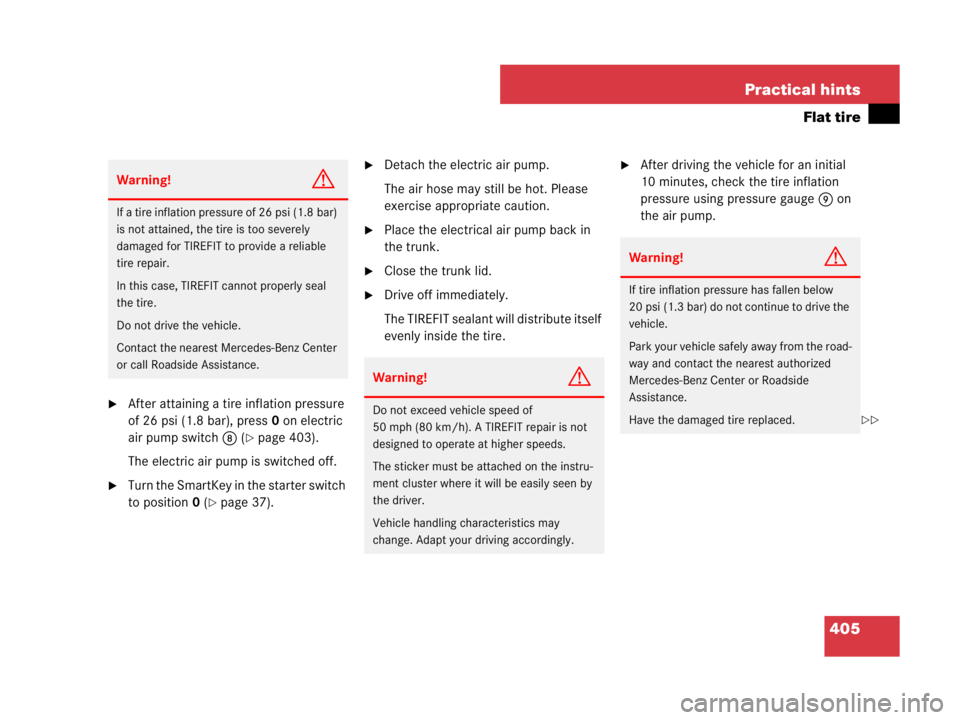
405 Practical hints
Flat tire
�After attaining a tire inflation pressure
of 26 psi (1.8 bar), press0 on electric
air pump switch8 (
�page 403).
The electric air pump is switched off.
�Turn the SmartKey in the starter switch
to position0 (
�page 37).
�Detach the electric air pump.
The air hose may still be hot. Please
exercise appropriate caution.
�Place the electrical air pump back in
the trunk.
�Close the trunk lid.
�Drive off immediately.
The TIREFIT sealant will distribute itself
evenly inside the tire.
�After driving the vehicle for an initial
10 minutes, check the tire inflation
pressure using pressure gauge 9 on
the air pump.
Warning!G
If a tire inflation pressure of 26 psi (1.8 bar)
is not attained, the tire is too severely
damaged for TIREFIT to provide a reliable
tire repair.
In this case, TIREFIT cannot properly seal
the tire.
Do not drive the vehicle.
Contact the nearest Mercedes-Benz Center
or call Roadside Assistance.
Warning!G
Do not exceed vehicle speed of
50 mph (80 km/h). A TIREFIT repair is not
designed to operate at higher speeds.
The sticker must be attached on the instru-
ment cluster where it will be easily seen by
the driver.
Vehicle handling characteristics may
change. Adapt your driving accordingly.
Warning!G
If tire inflation pressure has fallen below
20 psi (1.3 bar) do not continue to drive the
vehicle.
Park your vehicle safely away from the road-
way and contact the nearest authorized
Mercedes-Benz Center or Roadside
Assistance.
Have the damaged tire replaced.
��
Page 407 of 473
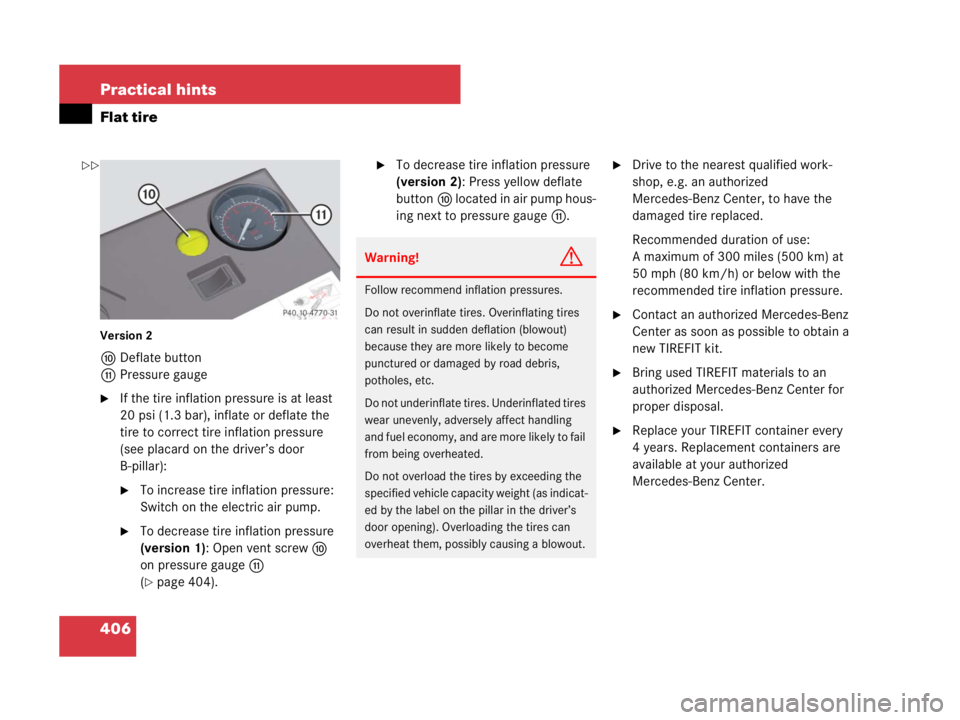
406 Practical hints
Flat tire
Version 2
aDeflate button
bPressure gauge
�If the tire inflation pressure is at least
20 psi (1.3 bar), inflate or deflate the
tire to correct tire inflation pressure
(see placard on the driver’s door
B-pillar):
�To increase tire inflation pressure:
Switch on the electric air pump.
�To decrease tire inflation pressure
(version 1): Open vent screwa
on pressure gaugeb
(
�page 404).
�To decrease tire inflation pressure
(version 2): Press yellow deflate
buttona located in air pump hous-
ing next to pressure gaugeb.�Drive to the nearest qualified work-
shop, e.g. an authorized
Mercedes-Benz Center, to have the
damaged tire replaced.
Recommended duration of use:
A maximum of 300 miles (500 km) at
50 mph (80 km/h) or below with the
recommended tire inflation pressure.
�Contact an authorized Mercedes-Benz
Center as soon as possible to obtain a
new TIREFIT kit.
�Bring used TIREFIT materials to an
authorized Mercedes-Benz Center for
proper disposal.
�Replace your TIREFIT container every
4 years. Replacement containers are
available at your authorized
Mercedes-Benz Center.
Warning!G
Follow recommend inflation pressures.
Do not overinflate tires. Overinflating tires
can result in sudden deflation (blowout)
because they are more likely to become
punctured or damaged by road debris,
potholes, etc.
Do not underinflate tires. Underinflated tires
wear unevenly, adversely affect handling
and fuel economy, and are more likely to fail
from being overheated.
Do not overload the tires by exceeding the
specified vehicle capacity weight (as indicat-
ed by the label on the pillar in the driver’s
door opening). Overloading the tires can
overheat them, possibly causing a blowout.
��